Sapphire Radeon R9 290 Review
Published by Hiwa Pouri on 20.08.14Page:
 The Radeon R9 290 has been introduced quite a while back and thanks to Sapphire we're finally having a look at the reference model. As you might already know, the card comes with a blower type cooler and clocked at 947 MHz on the GPU and 5'000 MHz for the memory. Overall we're curious to see what kind of damage this card can do.
The Radeon R9 290 has been introduced quite a while back and thanks to Sapphire we're finally having a look at the reference model. As you might already know, the card comes with a blower type cooler and clocked at 947 MHz on the GPU and 5'000 MHz for the memory. Overall we're curious to see what kind of damage this card can do.
 Article in English Article in English |
 Artikel in Deutsch Artikel in Deutsch |
 Article en français Article en français |
 Articolo in italiano Articolo in italiano |
Presentation
Today we're having a look at Sapphire's Radeon R9 290, which has been built
according to AMDs reference design. Therefore you get the standard cooler as
well as the usual PCB in combination with reference clocks. This review will
also show you what the R9 290 is able to score when it comes completely
reference.
As we already mentioned this is an AMD Radeon R9 290 graphics card, that's been build according to reference specifications. The GPU is therefore set to work at up to 947 MHz. A closer look at the memory reveals clocks are at 1'250 MHz (effective 5'000 MHz).
During our testing the Sapphie Radeon R9 290 constantly kept core clocks at 947 MHz. Usually, when we run Furmark, we see GPU clocks go down by quite a few MHz, but with this card that is not the case.

Specifications
| Sapphire Radeon R9 290 | Radeon R9 290X | ASUS Radeon R9 290 DirectCU II OC | |
| Chip | Hawaii Pro | Hawaii XT | Hawaii Pro |
| Process | 28 nm | 28 nm | 28 nm |
| Transistors | 6.20 billion | 6.20 billion | 6.20 billion |
| GPU clock | 947 MHz | up to 1'000 MHz | 1'000 MHz |
| Memory GDDR5 | 4'096 MB | 4'096 MB | 4'096 MB |
| Memory clock | 1'250 (5'000) MHz | 1'250 (5'000) MHz | 1'260 (5'400) MHz |
| Memory interface | 512 Bit | 512 Bit | 512 Bit |
| Memory bandwidth | 320 GB/s | 320.0 GB/s | 322.6 GB/s |
| Shader Cores | 2'560 | 2'816 | 2'560 |
| TMUs | 160 | 176 | 160 |
| ROPs | 64 | 64 | 64 |
| PCB Type | Reference Design | Reference Design | Custom Design |
| Slots | 2 | 2 | 2 |
| Cooler | AMD Reference | AMD Reference | DirectCU II |
| Navigate through the articles | |
 Raijintek Morpheus vs. DirectCU II - ASUS Radeon R9 290X DirectCU II
Raijintek Morpheus vs. DirectCU II - ASUS Radeon R9 290X DirectCU II |
Sapphire Dual-X R9 280 OC Edition Review
 |
|
|



